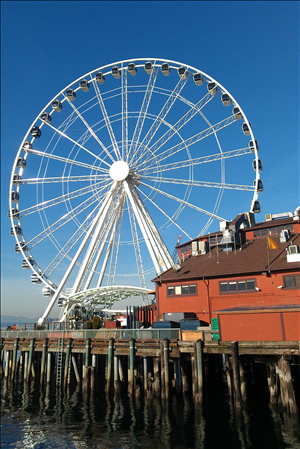On June 29, 2012, the Seattle Great Wheel opens to the public on the Seattle central waterfront. Located at the end of Pier 57, the 175-foot-high ride features 42 climate-controlled gondolas that can hold up to eight passengers each. One of the gondolas is a VIP gondola, with red leather seats and a glass floor, which seats four. Each ride is three full rotations of the wheel, and can last from 10 to 20 minutes. The Great Wheel rising high above the waterfront will soon become a Seattle icon and photographic subject to rival the Space Needle.
Pier Pressure
In 1989 businessman Hal Griffith purchased Pier 57 from the City of Seattle. There he opened Miners Landing, a collection of restaurants and shops leased out to tenants. With the pier located next to Waterfront Park and near the Seattle Aquarium, Griffith thought that a small Ferris wheel would make a good attraction for people visiting that area of the waterfront.
The Seattle parks department rejected several proposals that Griffith made to place a wheel in Waterfront Park. In the early 2000s, as city officials were making plans to tear down the viaduct and rebuild the seawall, Griffith and his sons Kyle and Troy worried that the construction projects would have a major impact on their business and decided to build a large wheel on the family's pier.
To support the massive ride, the end of the pier had to be torn down and rebuilt using galvanized steel pilings, three feet in diameter. Next came the Great Wheel's foundation, which was built by Issaquah-based B & T Design and Engineering using 550 tons of concrete. The pier and foundation had to be strong enough to support the 280,300 pound wheel and 54,500 pounds of riders.
Spinning Wheel
The Great Wheel itself was purchased from Kansas-based Chance Rides, a company making rides for amusement parks worldwide. The Griffiths chose the company's R60 model, which had previously been installed in two North American cities -- Myrtle Beach in South Carolina and Niagara Falls in Ontario, Canada. Seattle was the first city where that wheel was built over water.
After two years of planning and construction, the Seattle Great Wheel opened to the public on June 29, 2012. Festivities began at 2:30 p.m. and included speeches by Hal Griffith and Seattle Mayor Mike McGinn (b. 1959). Music was provided by the University of Washington Marching Band. Joan Griffith, Hal's wife, performed the ribbon-cutting ceremony, after which a long line of passengers made their way into the gondolas.
Dustin Boehlke, a 21-year-old University of Washington student, was given a pass to the VIP gondola for being the first rider in line. The first paying customer was Vince Wilson, a longshoreman from Roy, Pierce County, who arrived at 10:30 a.m., before installation of the ticket windows had even been completed. Tickets cost $13, with discounts for children and seniors.
After it opened, the Seattle Great Wheel quickly became one of the city's icons, appearing frequently in footage shown during televised sporting events, as well as on postcards and other souvenirs.

